Kraków 2007-05-10
105b Section 1952-10-31
Iljuszyn Ił-28
Poland
History
The bomber.

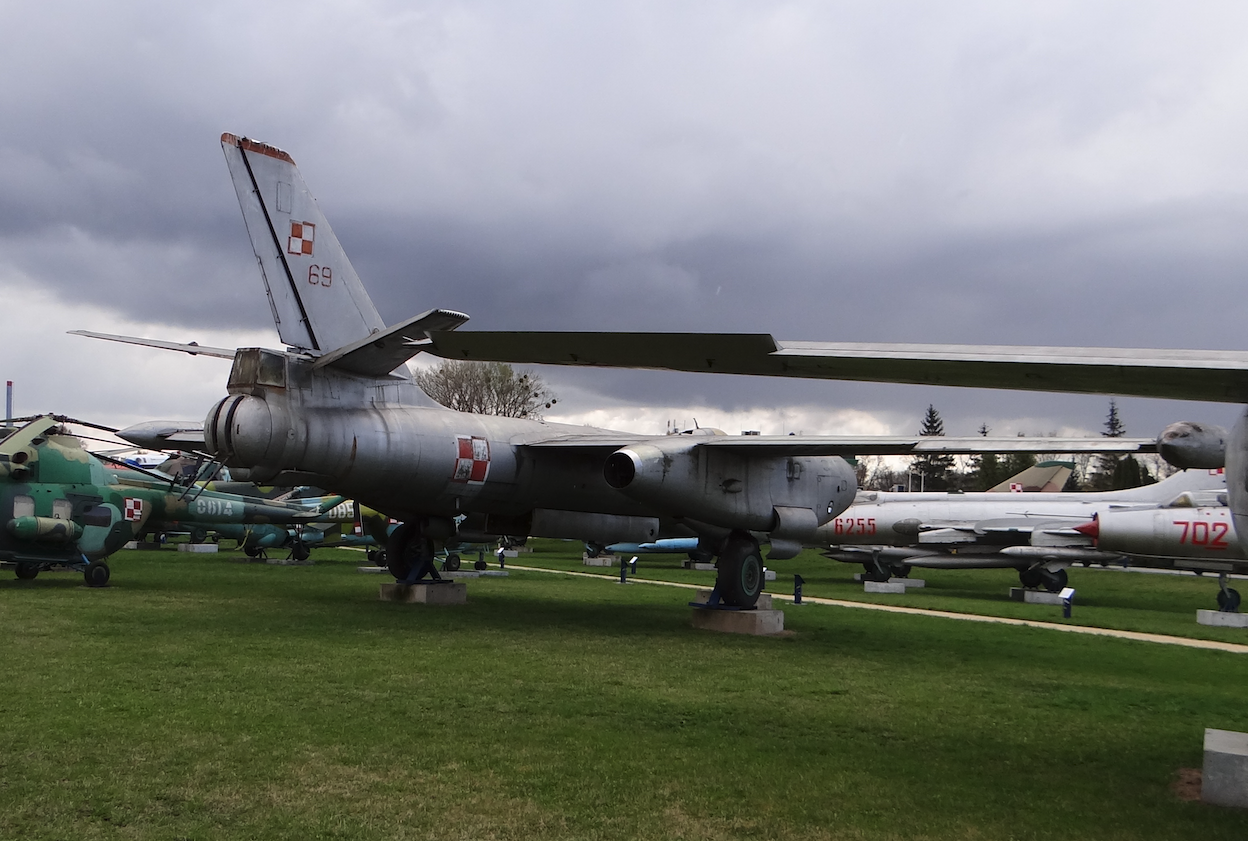
The history of the creation of Il-28. 1948.
In 1947, in the design offices (OKB) of Iljuszyn, Suchoja and Tupolev, work began on the design of a tactical (front) bomber with a turbojet, designed to operate on the front line and its close hinterland. The initial assumptions of the new aircraft placed great demands on the designers. The bomber should carry 1,000 kg of bombs, over a distance of 2,000 km, with a flight height of up to 11,000 m, its speed should be about 900 km / h, and the flight duration should be at least 2 hours at a cruising speed of 650-750 km / h.
Ilyushin had to solve many new problems, including the problem of small arms. In the first period of work on turbo-jet bombers, heated discussions took place over the armament of these machines. The installation of small arms decks had to increase the number of crew, increase the weight of the aircraft, deterioration of aerodynamic properties and, as a consequence, performance.
On the other hand, it was difficult to count only on the advantage of aircraft speed, the more so because the fighters were also getting faster speeds, and the radar sights allowed a potential enemy to open fire from a greater distance than it did in World War II. Ilyushin finally came to the conclusion that the bomber must be equipped with shooting positions to defend the rear half-zone and that to achieve this goal it is enough to have a tail turret, provided that it has a high rotation speed and a wide field of fire.
Ilyushin took advantage of the experience gained while designing the Il-22 bomber. Failures associated with this heavy bomber, encouraged the designer to intensify the effort and the work of his team progressed quickly. Reducing the crew to three people had a positive effect on reducing the weight of the structure. Another important issue was the division of the airframe into technological parts. This was not about reducing costs, but about increasing the accuracy of individual components. While accuracy for an aircraft flying at 500 km / h is not that important, for a 900 km / h machine it is very important. Ilyushin technologically divided the wings and horizontal tail along the chord, and the hull along the vertical plane of symmetry. The weight of the structure increased, but the quality of the elements made incomparably increased, and the labor intensity did not give way to the performance of a fighter aircraft.
On January 12, 1948, the design of the new aircraft was ready. In July 1948, the bomber plane program was officially included in the programming work of the Iljuszyn design office. Until now, the designer has carried out all work on the bomber on his own initiative.
On August 7, 1948, the crew included; pilot - W. K. Kokkinaki, radio operator - B. A. Jerofjejew, navigator - N. D. Sorokin, took off on the prototype bearing the designation Il-28. The plane was stable in horizontal flight, showed no tendency to fall into a corkscrew. Also, when flying with one engine running, the aircraft did not tend to get into a spin. Ascending bomber characteristics were also good. Landing by plane did not pose any difficulties for the pilot.
One of the weaknesses of the prototype was the rapid wear of tires when landing at a concrete airport. The tires had to be replaced after about ten landings. The situation was improved by the subsequent use of nylon covered tires.
The first copy and two subsequent prototypes flew with two British Nene engines, with a static thrust of 2 x 22.26 kN (2 x 2 270 kG). The thrust of the power unit was small in relation to the weight of the aircraft. But even with these engines, the bomber showed good performance. The aircraft developed a speed of 800 km / h, with a load of 1,000 kg bombs at an altitude of 11,000 m, and the maximum speed was 833 km / h, at an altitude of 5,000 m (Ma = 0.79).
A major disadvantage of Nene engines was the large diameter and relatively low thrust. This weak point of the drive had to be eliminated first. On December 30, 1948, the IL-28 prototype was flown with Soviet RD-45 F turbojet engines, a modified version of Nene. However, on August 8, 1949, the bomber rose to the first flight with WK-1 engines, which are the development version of the RD-45 F and later installed in serial copies. New engines were placed in slightly changed covers with a new profile, favorable in terms of aerodynamics. The covers were narrowed at the junction with the wings.
Other changes were also made to the aircraft. A new version of the glazing of the navigator-bombardier and pilot station was used, and the radar station was moved from under the tail portion of the fuselage in front of the bomb chamber. All changes were then introduced on serial aircraft.
The bomber made state tests between February and April 1949. Still with RD-45 engines. Good opinion about its piloting, as well as the simplicity of ground handling, determined the acceptance of the aircraft for serial production. At the same time, work on competing planes: Sukhoi (Su-10) and Tupolev Tu-14 (Tu-78) was suspended. In May 1949, a conference was held at the Kremlin at Stalin's. At the meeting, decisions were made to start serial production of Il-28 aircraft and to build a short Tu-14 series for maritime aviation. The reason for returning to the Tu-14 aircraft design was the greater range and longer bomb chamber housing the torpedoes without difficulty.
Production of Ił-28 bombers.
At the end of 1949, the IL-28 bomber underwent final tests with WK-1 engines developed by W. Klimow and field tests. In the same year a decision was made to start mass production of the Ilyushin bomber at three large aviation plants. Factories in Moscow, Voronezh and Omsk were selected. In the spring of 1950, the first serial copies became part of the bomb regiments, and during the May 1 parade in 1950, 25 IL-28 bombers flew over Red Square.
The Il-28 bomber was the last combat aircraft of Ilyushin, which was qualified for serial production.
The Il-28 series production lasted until 1956. A total of 6 317 IL-28 aircraft were built, of various versions, including: 4 406 bombers, 1 405 school bombers, 506 reconnaissance aircraft. At the peak of production, in the years 1953–1954, 150 planes were produced per month, which means that 4-5 regiments could be equipped with these planes per month!
Il-28 aircraft were armed; East Germany (German Democratic Republic), Czechoslovakia (where license production was undertaken), Hungary, Poland, Bulgaria, China (PRC, where license production was undertaken), Albania (machines from CCCP and China), Algeria, Egypt (machines from Czechoslovakia), Iraq , Morocco, Nigeria, Somalia, Yemen, Afghanistan, Indonesia, Cambodia, the KRL-D (Ludowa Korea) and Vietnam.
Written by Karol Placha Hetman
Kraków 2007-05-10
105b Section 1952-10-31
Iljuszyn Ił-28
Poland
Construction
The bomber.
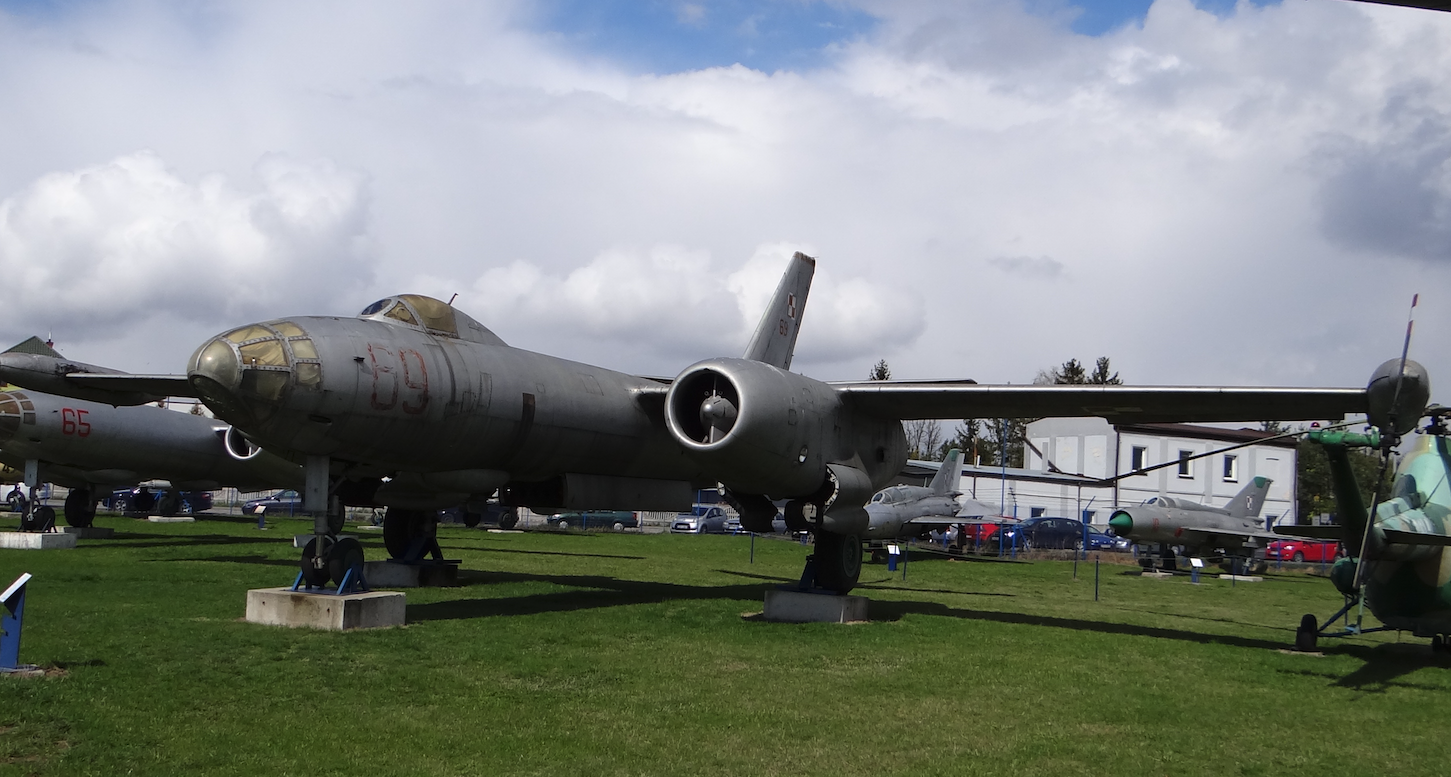
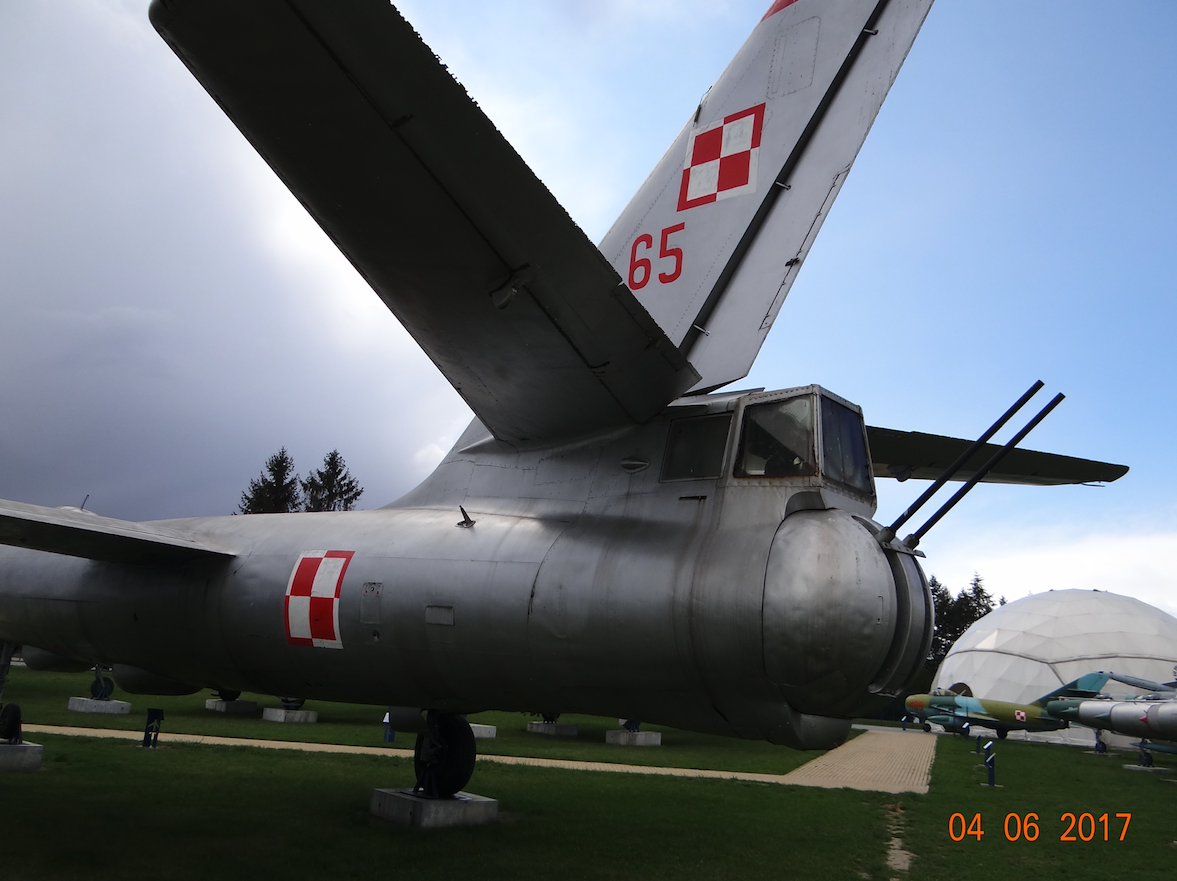
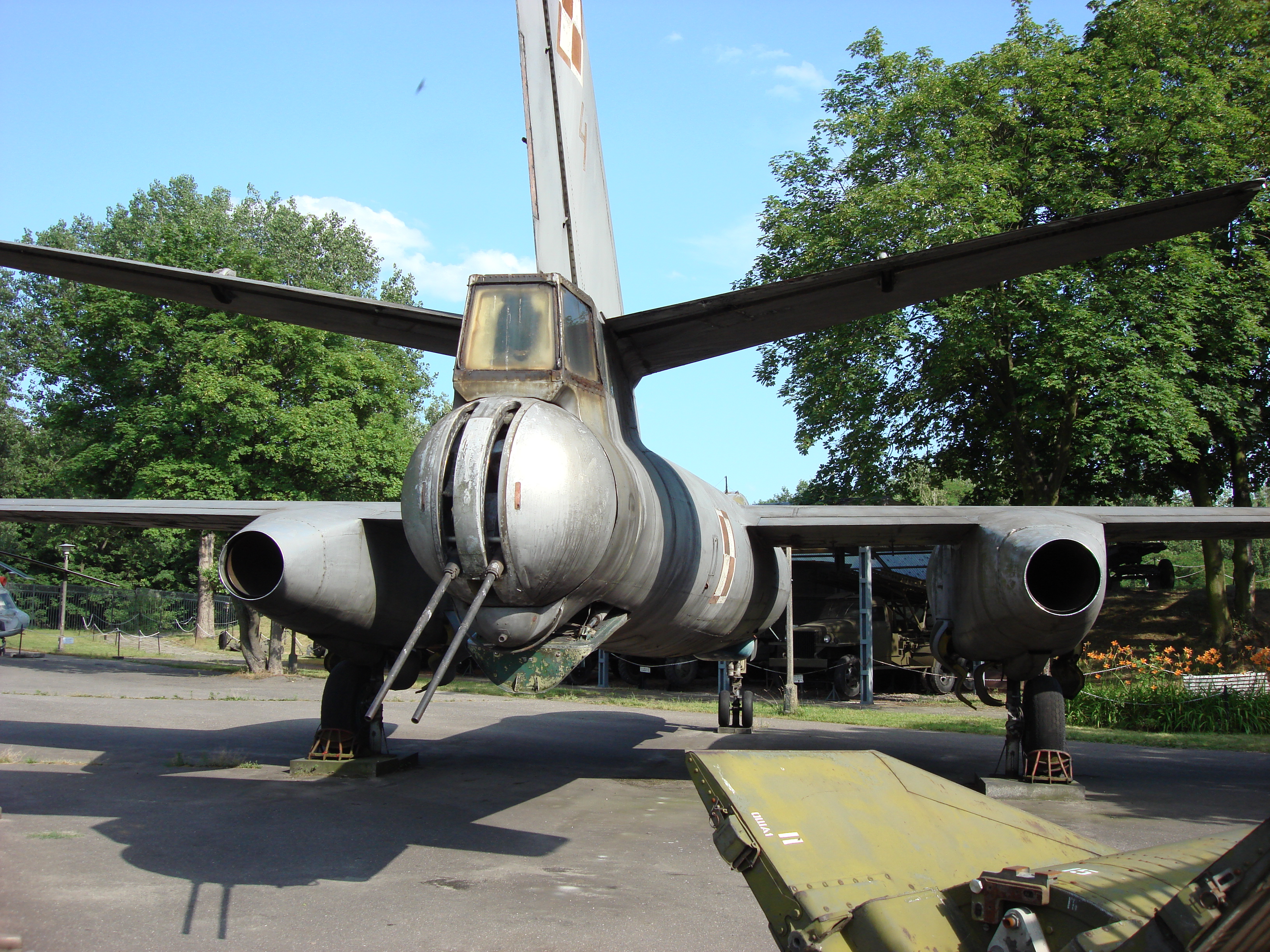
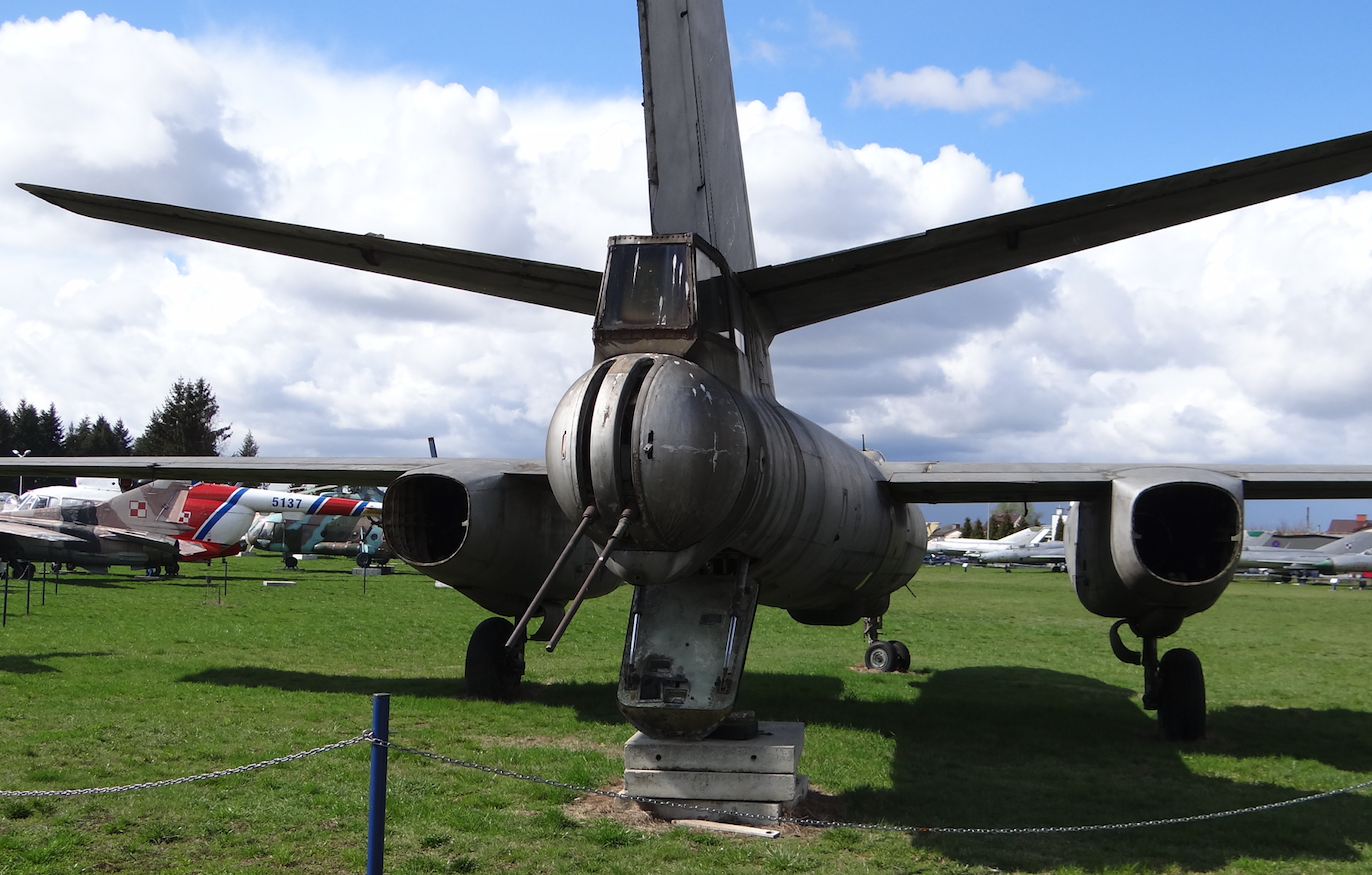
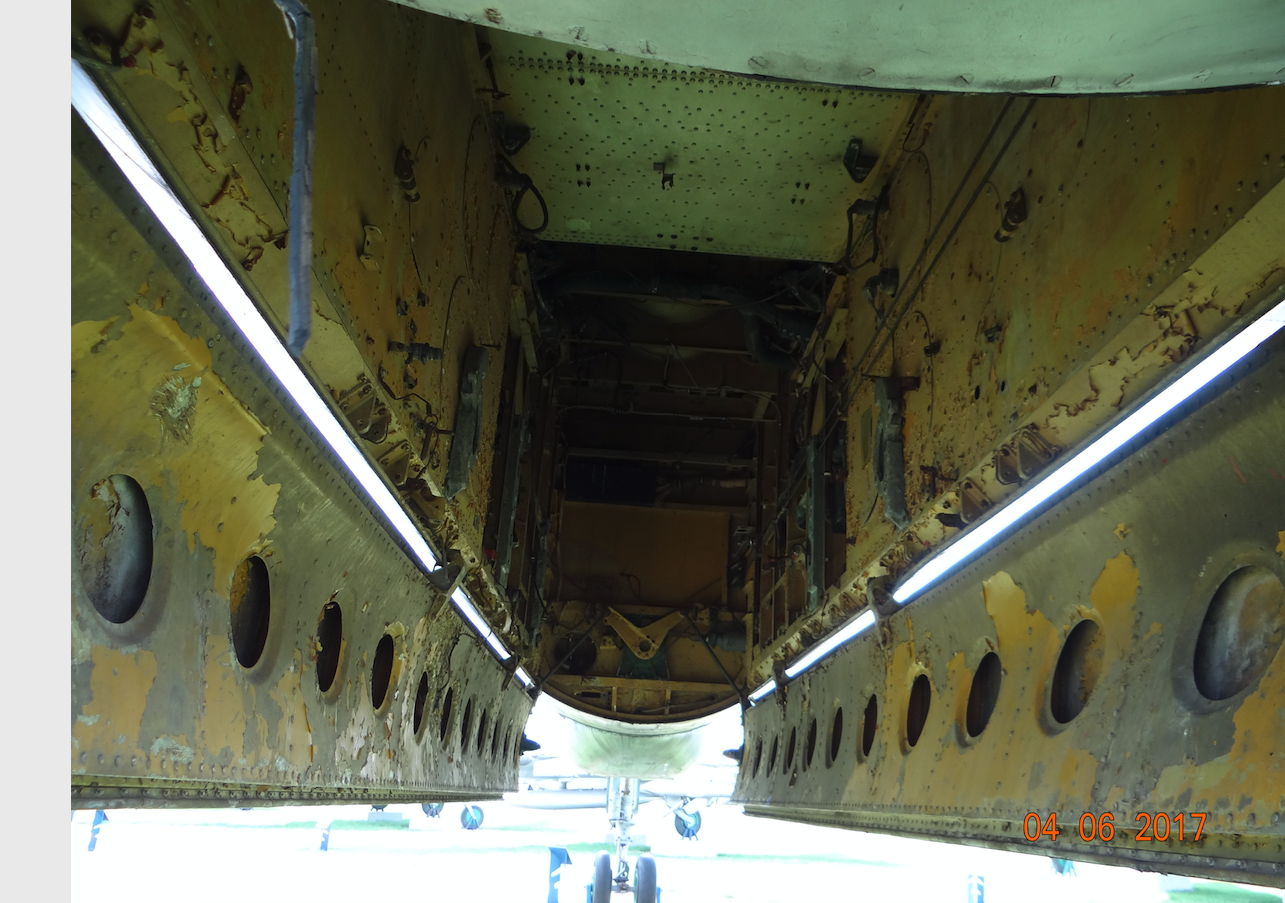
Construction Ił-28. 1948.
The Il-28 is a three-person, twin-engine, all-metal bomber-reconnaissance-school-tug-aim-WRe. Built in a classic high-wing arrangement, with a straight wing and oblique tail, both horizontal and vertical.
The aircraft structure has been technologically divided into several separate elements. The wings were divided along the chord and the hull along the frames. Such technology slightly increases the weight of the structure, but significantly simplifies production, and individual components are made much more accurately. The basic material used for construction is duralumin and steel.
The wings are straight, with a trapezoidal contour. The wing profile is laminar, type SR-5s, with a relative thickness of 12%. The wing has significant elongation. A small positive lift, 0 degrees and 38 minutes, and wedged against the hull at an angle of 0 degrees. The wing is technologically made of three parts. The central wing forms one unit with the central part of the hull. The outer parts of the sash are easily attached. The wing wing center has a double girder structure. The girders are T-shaped. The external parts of the wings have a single-girder structure with an auxiliary girder. The panel cover was formed by duralumin sheets 1.5-4.0 mm thick. The wings are equipped with flaps and ailerons. The flaps with an area of 7.45 m2, are swung out hydraulically, for takeoff by an angle of 20 degrees, for landing by an angle of 50 degrees. The shuttlecocks are moved by the strength of the pilot's muscles, tilted up 15 degrees, down 20 degrees. There is a balance flap on the right aileron. Engine nacelles were hung under the wings.
The wing edges are de-iced with hot air taken from the engine compressor. Hot air flows inside the wing nose and leaves the wing with the holes placed at the end of the wing.
Straight wings are less favorable for high speeds, but much better for smaller speeds. Straight wings ensure the speed of the Ma-0.82 aircraft at an altitude of 7,000 - 8,000 m, which was a satisfactory result.
Circular fuselage. The maximum hull diameter is 1.80 m and the maximum height is 2.18 m. The fuselage skeleton is made of duralumin with increased durability, with working aluminum cover, 1.0-2.0 mm thick. The front part of the fuselage is airtight and equipped with a pressure system, it includes a pilot's cabin covered with a drip contour and a navigator-bombardier stand, in the richly glazed nose cone of the fuselage. The thickness of the laminated glass in the windows is 10-16.5 mm. Behind the navigator cockpit there is a pilot's cockpit. The front landing gear compartment is located under the pilot's cabin.
Behind the pilot's cabin, under the bottom of the fuselage, there is an on-board radar antenna placed in a plastic cover. The middle part of the fuselage is bolted to the front. The middle part of the hull has no pressure system and in the upper part it contained 5 so-called "soft" fuel tanks, with a total capacity of 7,980 liters, located in front of and behind the center wing. Three front group tanks supply the right engine and two rear fuel tanks left engine. The emergency system allowed each engine to be powered from one or another group of fuel tanks. In the middle of the fuselage, below the fuel tanks, there is a bomb chamber, 4.18 m long, 0.95 m wide, and 1.10 m high. is equipped with four catches for 500 kg bombs and one central catcher for 1,000, 2,000 or 3,000 kg bombs. The largest classic bomb used in the CCCP was the 3,000 kg KAB-3000 bomb. the fuselage is bolted to the middle section. A tail is attached to the rear of the fuselage. At the rear of the fuselage there is a container for a braking parachute with a diameter of 7 m, which shortens the run-out during landing.
The flight crew consists of three pilots; Pilot-commander - takes place in a hunting-type cabin on the hull back. To allow the pilot to take up space, the central part of the fairing is tilted manually to the right. There is a catapult chair in the cabin. The pilot's seat is armored at the back and bottom with armor plates 6-10 mm thick. In an emergency, the pilot catapults up as the second one after the navigator. There was a PKI gyroscope sight in the cockpit.
The navigator-bombardier takes its place in the glass nose of the plane. To take up space in the cockpit, a hatch located in front of the pilot's cockpit on the hull's back, tilts to the left. When operating navigational-bomb equipment, the navigator sits on a folding chair mounted on the right side of his cabin and protected from below by a 10 mm thick armor plate. For aiming while bombing, use the optical sight OPB-5 S or radar sight PSBN-M-8 (for bombardment without sight of the target). The bomb sight is coupled with the AP-5 automatic pilot. The navigator can control the aircraft without the participation of a pilot. When the navigator does not operate its equipment, it sits in a rear catapult seat, protected from below by an 8 mm thick armor plate and from above by dural sheet 32 mm thick. The hatch to the navigator cabin is tilted left and is located above the catapult chair.
The gunner-radio operator takes place in the Ił-K 6 turret at the end of the fuselage. Access is provided by a manhole with steps located at the bottom of the hull. There is no reclining chair in the cabin, and the flier evacuates through this hatch with a rescue parachute. The turret is hermetic, pressure and well armored. The turret is glazed with bulletproof multi-layer glass, 102 mm thick, in the front part and 68 mm, side windows. Later glazing introduced bulletproof glass ceiling. Containers with ammunition are shielded with aluminum armor plates, 8 mm thick. The sides of the turret have duralar armor 10 mm thick.
Two 23 mm cannons were placed in the turret, in a set weighing 340 kg without ammunition and 635 kg with ammunition. The plot position is rotated electrohydraulically, which ensures high speed of movement. The field of fire is: horizontally in the range of 70 degrees, to the right and left and in a vertical plane in the range of 60 degrees upwards and 40 degrees downwards. The rotation speed of the plots is 15-17 degrees per minute, and if necessary even 36 degrees per minute. The fire is effective at a flight speed of up to 1,000 km / h. The turret driving mechanism was designed in a rather original way. The main element of the rotary mechanism was the AKP-5 hydraulic aggregate, started by two electric motors with a total power of 5 kW (6.8 HP). The angle of swing of the pumps determined the speed of fluid flow in the hydraulic system, and thus the turret rotation speed. It was a fairly simple mechanism with high reliability. The turret was guided to the target using a semi-automatic gyroscope sight with readout of fire parameters. The warning radar with antenna above the gunner's cabin provides information about the threatening attack of fighters from the rear half-zone.
The total mass of the IL-28 bomber's armor was 454 kg. From a flight height of 1,700 m, the cabins are insulated from the surrounding atmosphere. The pressure system meant that at an altitude of 5,000 m, the pressure in the cabins was equivalent to that at an altitude of 2,500 m. However, at an altitude of 12,000 m it corresponded to an existing pressure at an altitude of 4,250 m. Engine compressors pumped heated air into the cabins. The air blowing system was a uniform system with the ventilation and heating system. Access to all elements of the hull was easy, installation and replacement of equipment in field conditions was quick.
The formation of the Il-28 aircraft is oblique to improve controllability in a fast dive flight. The self-supporting tail is characterized by a significant slope of the vertical and horizontal stabilizer: 41 degrees and 33 degrees, respectively, along the leading edge. The horizontal crest with a span of 7.36 m and an area of 10.82 m2, has a positive rise of 7 degrees. Horizontal and vertical ballasts have a caisson structure with two girders. The vertical tail area was 7.80 m2. There are trimmers at the helm and helm. Swing range of the horizontal rudder: 32 degrees up and 13.5 degrees down. Vertical rudder range: 25 degrees right and left. The design of the tail promotes good flight characteristics at high speeds.
The Il-28 triple chassis consists of a front shin with two wheels. The front landing gear retracts back into the chamber in the front of the hull (600 x 155 mm wheels, later 600 x 185 mm). The main chassis is two shaves with single wheels (initially 1140 x 350 has later 1150 x 355 mm), retracts forward in the engine covers, with a simultaneous rotation of 90 degrees. The main chassis is retractable in chambers located in the engine nacelles, which gives them a large spacing.
Power of Il-28 aircraft
The propulsion of the aircraft consists of two WK-I A turbine jet engines, with a static thrust of 2 x 26.48 kN (2 x 2 700 kG), located in the front part of the nacelle, in front of the leading edge of the wings. These are the same engines that were used to propel MiG-15 bis and Lim-2 fighters, so they were produced in Poland under the designation Lis-2.
During the operation of IL-28 bombers from short runways, it was possible to use two auxiliary rocket launch engines PSR-1500 with a weight of 240 kg, mounted on both hull floors under the wings. They developed a static string of 2 x 16.18 kN (2 x 1 650 kG) and operated for 13 seconds. The pilot started them at a speed of 100-120 km / h. At the bomber's take-off weight of 17,220 kg, they allowed them to reduce the take-off to 560 m.
Ił-28 aircraft equipment
Control system - Almost the entire control system, except for hydraulically extendable flaps, was moved by the strength of the pilot's muscles. Serial models developed a maximum speed of 906 km / h at an altitude of 4,000 m, with a normal take-off mass of 18 400 kg. Piloting conditions and flight stability were very good. The maximum allowable speed corresponded to the value of Mach number Ma-0.82, was limited (during the service) to Ma-0.794 at an altitude of 11,000 m. In such conditions the Il-28 aircraft was still steerable, no vibration was observed, although at Ma-0.78 resistance on the joystick increased. With the rudder trimmer tilted, the aircraft could reach Ma-0.81, but then the vibration of the tail increased, then the entire aircraft and the pilot had to reduce speed.
The anti-icing system in which the bomber was equipped supplied heated air from engine compressors to the leading edge of the wings and the tail through the duct system. The weight of this installation is 70 kg.
The Il-28 planes adapted for towing aerial targets had a drum assembled in the bomb chamber with a reeled rope of 2,500 m length, at the end of which was a shooting sleeve.
Avionika aircraft Il-28
The RSB-5 on-board radio operated by the navigator was used to maintain long-range communication with the ground. The radio equipment altimeter RW-10 belonged to the basic equipment of the aircraft. On-board radio station RSIU-3M for maintaining communication with other planes flying in formation and for short-range communication with the ground. Radio altimeter RW-2. ARK-5 automatic radio compass. Automatic pilot AP-5. Internal on-board communication system. Own radar identification system.
Armament of the Il-28 aircraft
The bomb chamber normally holds 1,000 - 2,000 kg of bombs. It can also contain one KAB-3000 bomb weighing 3,000 kg.
The permanent armament of the aircraft are two 23mm cannons placed symmetrically in the lower front of the fuselage. The cannons used on the plane are type NS-23 or newer NR-23.
The tail turret is described above.
Changes in Il-28 (Il-28 U) compared to Il-28.
UIł-28 aircraft received a rebuilt front of the fuselage. A pilot-instructor cockpit was built in the nose. A catapult chair was placed here, which was fired up after rejecting the fairing. Pilots and radio operators were trained on this plane. UIł-28 (Il-28U) had no shooting or bomber equipment, but if necessary it was possible to install the cannon in the tail turret. The Il-28 (Il-28U) aircraft was the lightest version of the Il-28 aircraft and was therefore used to study the upper atmosphere.
Changes in the aircraft Il-28 R.
Reconnaissance equipment was placed in the bomb chamber and in the rear of the Il-28 R aircraft. It consists of several cameras - vertical and skewed cameras. The Il-28 R aircraft was equipped with a PSBN radar (radar station), which has a range of 15 to 100 km, depending on the flight altitude. Additional fuel tanks were placed at the ends of the Il-28 R wings that were not discarded. The maximum take-off weight of the Il-28 R aircraft increased to 22 720 kg, therefore this version received larger diameter landing gear wheels. The Il-28 R aircraft has only one cannon mounted in the front of the fuselage. The aircraft has no rear shooting turret.
The Il-28 R aircraft have a hydraulic system as the basic one. Hydraulic system: extends the wing flaps, retracts and extends the landing gear, directs the front wheel. The pneumatic installation is supportive and emergency.
Changes in Il-28 E. 1965.
In the mid-60s, CCCP purchased sets of electronic warfare apparatus (WRe) and 10 Polish Il-28 bomber aircraft converted into Wre aircraft, designated Il-28 E. Each set was equipped with an SRS-2 or SRS- radiotechnical reconnaissance station 3 and the station of active electronic interference SPS-2 or ejector cut ASO-28 metallized film (popular "chaff-cutter").
In the Polish Army, Il-28 E aircraft were used for various tasks. Ił-28 E aircraft performed reconnaissance flights over the Baltic Sea. They collected information about working radars in Sweden, Denmark and Germany. They recognized surface vessels and Western aircraft. Ił-28 E aircraft were involved in the location of accidents and disasters on the Baltic Sea. Ił-28 E aircraft also performed reconnaissance flights along the western border of Poland. During the exercises, the crews of Il-28 E planes prepared to simulate war operations aimed at misleading the enemy. They were taught to disrupt enemy radars. Bomb raids were simulated that were not actually present, i.e. demonstration tasks.
From 1970, Il-28 E aircraft were replaced in the reconnaissance tasks with MiG-21 R aircraft.
Data T-T Ił-28
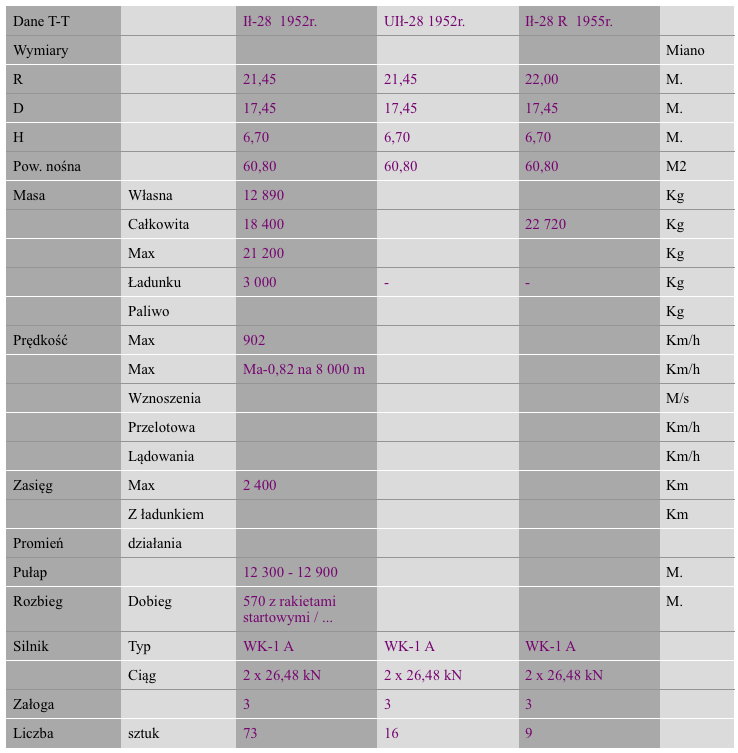
Written by Karol Placha Hetman
Kraków 2007-05-10
105b Section 1952-10-31
Iljuszyn Ił-28
Poland
Tally
Bomber, school, reconnaissance aircraft, target tug, WRe (radio-electronic fight).
Ił-28
Ił-28 bombers. The Polish Army had 73 copies. The planes were accepted in 1952-1956.
Ił-28 aircraft were brand new. They were left in a natural duralumin color. The chessboard was painted on a vertical tail, the rear part of the fuselage and wing. Side (side) numbers were painted in accordance with Soviet standards. The aircraft received subsequent ordinal numbers not related to serial numbers. And yes; 7 PLB - numbers from 1 to 20, 33 PLB - from 21 to 40, 35 PLM - (from 1954, when Ił-28 planes began to take over) from 40 to 60. Most importantly, the numbers were in different colors, depending on from belonging to a given regiment. And yes; 7 PLB had side numbers in red, 33 PLB - in blue, 35 PLB - in dark yellow with a navy blue border. Over the years, as aircraft were transferred to other units (21. SPLR - independent reconnaissance aviation regiment, 15. SELR MW - independent naval reconnaissance squadron, OSL-4 in Dęblin, 19. LEH - air towing squadron), rules of ordered numbers in squadrons. For example, in 35 PLB, subsequent tactical numbers from the "60", "70" and "80" series were introduced.
1 Il-28 nb 1. Delivered to Bydgoszcz on October 31, 1952. Adopted as of 7 PLB.
2 Ił-28 nb 2. Delivered to Bydgoszcz on October 31, 1952. Adopted as of 7 PLB.
3 Ił-28 nb 3. Delivered to Bydgoszcz on October 31, 1952. Adopted as of 7 PLB.
4 Ił-28 nb 4, no. 1910. Delivered to Bydgoszcz on October 31, 1952. Adopted as of 7 PLB. After service, he is an exhibit at the Poznań Citadel.
5 Ił-28 nb 5. Delivered to Bydgoszcz on October 31, 1952. Adopted as of 7 PLB.
6 Ił-28 nb 6. Delivered to Bydgoszcz on October 31, 1952. Adopted as of 7 PLB.
7 Ił-28 nb 7. Delivered to Bydgoszcz on October 31, 1952. Adopted as of 7 PLB.
8 Ił-28 nb 8. Delivered to Bydgoszcz on October 31, 1952. Adopted as of 7 PLB.
9 Ił-28 nb 9. Delivered to Bydgoszcz on December 11, 1952. Adopted as of 7 PLB.
10 Ił-28 nb 10. Delivered to Bydgoszcz on December 11, 1952. Adopted as of 7 PLB.
11 Ił-28 nb 11. Delivered to Bydgoszcz on December 11, 1952. Adopted as of 7 PLB.
12 Ił-28 nb 12. Delivered to Bydgoszcz on December 11, 1952. Adopted as of 7 PLB.
13 Ił-28 nb 13. Delivered to Bydgoszcz on December 11, 1952. Adopted as of 7 PLB.
14 Ił-28 nb 14. Delivered to Bydgoszcz on December 11, 1952. Adopted as of 7 PLB.
15 Ił-28 nb 15. Delivered to Modlin in 1953. Adopted as of 7 PLB.
16 Ił-28 nb 16. Delivered to Modlin in 1953. Adopted as of 7 PLB.
17 Il-28 nb 17. Delivered to Modlin in 1953. Adopted as of 7 PLB.
18 Ił-28 nb 18. Delivered to Modlin in 1953. Adopted as of 7 PLB.
19 Il-28 nb 19. Delivered to Modlin in 1953. Adopted as of 7 PLB.
20 Ił-28 nb 20. Delivered to Modlin in 1953. Adopted as of 7 PLB.
21 Ił-28 nb 21. Delivered to Modlin in 1953. Adopted as of 33 PLB.
22 Ił-28 nb 22. Delivered to Modlin in 1953. Adopted as of 33 PLB.
23 Il-28 nb 23. Delivered to Modlin in 1953. Adopted as of 33 PLB.
24 Ił-28 nb 24. Delivered to Modlin in 1953. Adopted as of 33 PLB.
25 Ił-28 nb 25. Delivered to Modlin in 1953. Adopted as of 33 PLB.
26 Il-28 nb 26. Delivered to Modlin in 1953. Adopted as of 33 PLB.
27 Ił-28 nb 27. Delivered to Modlin in 1953. Adopted as of 33 PLB.
28 Il-28 nb 28. Delivered to Modlin in 1953. Adopted as of 33 PLB.
29 Ił-28 nb 29. Delivered to Modlin in 1953. Adopted as of 33 PLB.
30 Ił-28 nb 30. Delivered to Modlin in 1953. Adopted as of 33 PLB.
31 Il-28 nb 31. Delivered to Modlin in 1953. Adopted as of 33 PLB.
32 Ił-28 nb 32. Delivered to Modlin in 1953. Adopted as of 33 PLB.
33 Il-28 nb 33. Delivered to Modlin in 1953. Adopted as of 33 PLB.
34 Ił-28 nb 34. Delivered to Modlin in 1953. Adopted as of 33 PLB.
35 Ił-28 nb 35. Delivered to Modlin in 1953. Adopted as of 33 PLB.
36 Il-28 nb 36. Delivered to Modlin in 1953. Adopted as of 33 PLB.
37 Il-28 nb 37. Delivered to Modlin in 1953. Adopted as of 33 PLB.
38 Ił-28 nb 38. Delivered to Modlin in 1953. Adopted as of 33 PLB.
39 Ił-28 nb 39. Delivered to Modlin in 1953. Adopted as of 33 PLB.
40 Ił-28 nb 40. Delivered to Modlin in 1953. Adopted as of 33 PLB.
41 Ił-28 nb 41. Delivered to Modlin in 1953. 35 PLB Modlin, in October 1955 eye, transferred to the 21 SPLR in Sochaczew.
42 Ił-28 nb 42. Delivered to Modlin in 1953. 35 PLB Modlin, in October 1955 eye, transferred to the 21 SPLR in Sochaczew.
43 Ił-28 nb 43. Delivered to Modlin in 1953. 35 PLB Modlin, in October 1955 eye, transferred to the 21 SPLR in Sochaczew.
44 Ił-28 nb 44. Delivered to Modlin in 1953. 35 PLB Modlin, in October 1955 eye, transferred to the 21 SPLR in Sochaczew.
45 Ił-28 nb 45. Delivered to Modlin in 1953. 35 PLB
46 Ił-28 nb 46. Delivered to Modlin in 1953. 35 PLB
47 Il-28 nb 47. Delivered to Modlin in 1953. 35 PLB
48 Ił-28 nb 48. Delivered to Modlin in 1953. 35 PLB
49 Ił-28 nb 49. Delivered to Modlin in 1953. 35 PLB
50 Ił-28 nb 50. Delivered to Modlin in 1953. 35 PLB. Parade 1957 - Capt. J. Czernecki, Capt. B. Gobis, sergeant E. Patrzałek.
51 Il-28 nb 51. Delivered to Modlin in 1954. 35 PLB.
52 Ił-28 nb 52 No. 2113. Delivered to Modlin in 1954. 35 PLB.
53 Il-28 nb 53. Shipped in 1954. 35 PLB.
54 Il-28 nb 54. Shipped in 1954. 35 PLB.
55 Ił-28 nb 55 No. 56701. Delivered on June 9, 1955. 35 PLB Modlin. Defilada 1957 - lieutenant B. Dopierała, lieutenant J. Balcerzak, sergeant J. Rzeszuto. From this plane on 3-4 September 1957. Capt. Tadeusz Dulla made record skydiving with a delay of 8,000 m and 12,950 m.
56 Il-28 nb 56 No. 56710. Delivered on June 9, 1955. 35 PLB Modlin. Parade 1957 - Major J. Figarski, Capt. J. Karaś, see W. Sucharzewski.
57 Il-28 nb 57 No. 56716. Delivered on June 9, 1955. 35 PLB Modlin. Defilada 1957 - second lieutenant Olszewski, second lieutenant E. Kulawik, sergeant Patrzałek.
58 Il-28 nb 58 No. 56721. Delivered on June 9, 1955. 35 PLB Modlin.
59 Ił-28 nb 59 No. 56724. Delivered on June 9, 1955. 35 PLB Modlin. Parade 1957. - Capt. W. Bira, lieutenant S. Różański, pluton J. Grabowski.
60 Il-28 nb 60 No. 56735. Delivered on June 9, 1955. 35 PLB Modlin.
61 Il-28 nb 61. Shipped in 1955. 35 PLB Modlin.
62 Il-28 nb 62. Delivered in 1955. 35 PLB Modlin.
63 Il-28 nb 63. Shipped in 1955. 35 PLB Modlin.
64 Il-28 nb 64 No. 2113. Delivered in 1955. 35 PLB, then 7 PLB. In 1978, handed over to the museum in Kołobrzeg. He wears a false nb 52.
65 Il-28 nb 65 No. 56729. Delivered in 1955. 35 PLB Modlin. In 1965 rebuilt to version Ił-28 E.
66 Il-28 nb 66. Delivered in 1955. 35 PLB Modlin.
67 Il-28 nb 67. Delivered in 1955. 35 PLB Modlin.
68 Il-28 nb 68. Delivered in 1955. 35 PLB Modlin.
69 Il-28 nb 69 No. 41302. Delivered in 1955. 35 PLB Modlin.
70 Il-28 nb 70. Shipped in 1955. 35 PLB Modlin. Parade 1957, - Capt. L. Jędrzejczyk, Capt. S. Garbowski, lieutenant S. Ziomek.
71 Il-28 nb 71. Shipped in 1955. 35 PLB Modlin. Defilada 1957, - lieutenant J. Treutz, second lieutenant M. Tęgos, senior sergeant H. Szykowski.
72 Il-28 nb 72 No. 41909. Delivered in 1955. 35 PLB Modlin.
73 Il-28 nb 74. Shipped in 1955. 35 PLB Modlin. The parade 1957 - lieutenant E. Jakubiec, lieutenant R. Szafrański, Corporal H. Gadaj.
74 Il-28 nb 75. Shipped in 1955. 35 PLB Modlin. Parade 1957 - Second Lieutenant L. Karcher, second lieutenant Z. Kielan, Corporal S. Maliszewski.
75 Il-28 nb 77. Delivered in 1955. 35 PLB Modlin. Defilada 1957 - lieutenant Z. Ziętek, lieutenant J. Sowa, sergeant J. Mouse.
76 Il-28 No. 81 No. 56606209. Delivered on January 17, 1956. 35 PLB Modlin.
77 Il-28 nb 82 No. 56606216. Delivered on January 17, 1956. 35 PLB Modlin.
78 Il-28 No. 83 No. 56606212. Delivered on January 27, 1956. 35 PLB Modlin.
79 Il-28 nb 85. Delivered in 1956. 35 PLB Modlin. Parade 1957 - lieutenant E. Ziaja, lieutenant H. Rożenek, sergeant S. Pawlik.
80 Il-28 nb 86. Shipped in 1956. 35 PLB Modlin. The parade 1957 - lieutenant H. Kozłowski, lieutenant J. Pieczywek, corporal A. Szeliga.
The Polish Army received 76 IL-28 bomber planes. The planes were moved between units and therefore the board numbers were changed. There were even planes with side numbers: 111, 133.
UIł-28
Polish Army 16 school aircraft, which have the designation UIł-28. UIł-28 school planes also received consecutive ordinal numbers preceded by the letter S. In the documents, markings with the letter U were also used.
The first UIł-28 nb S 1 aircraft No. 64204 was delivered on December 11, 1952, to Bydgoszcz to 7 PLB.
During the service, only one UIł-28 nb S 3 aircraft used in 15 SELR-MW was lost. On 11.01.1958, during the flight for weather recognition, the UIł-28 school aircraft collided with the ground (SIł-28 No. S-3, U-3). On the spot killed the entire crew composed of: instructor kmdr. Sec. pil. Hilary Zarucki (commander of the Squadron), 2nd lieutenant margins. pil. Walenty Urbanowicz, X-ray shooter. senior mar Jan Czubiński.
Ił-28 R
The Polish Army received 9 reconnaissance aircraft, which were designated Il-28 R. All aircraft were delivered in 1956. Reconnaissance aircraft Il-28 R, received sequential order numbers preceded by zero. Of course, there were exceptions. The aircraft were used mainly in 21 SPLR Sochaczew and 15 SELR Siemirowice.
During the service, one Ił-28 R aircraft was lost, which was used in 15 SELR-MW Siemirowice. On March 18, 1959, one year after taking up the duties of the Squadron Commander, Capt. margins. pil. Leon Jędrzejczyk, and with him the navy lieutenant Aleksander Czyżykowski and naval radiotelegraphist Adam Bochenek, died the death of an aviator when their Il-28 R flew into the air after a too vigorous maneuver over the home airport.
Ił-28 E
10 radio-electronic reconnaissance kits were purchased for Il-28 aircraft in the 1960s. The sets were mounted on 10 Il-28 aircraft.
Written by Karol Placha Hetman
